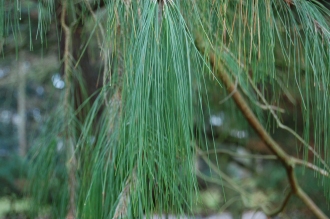Position: Full sun
Flowering period: Spring
Soil: Moist, well drained
Eventual Height: 40m
Eventual Spread: 20m
Hardiness: 8b, 9a, 9b, 10a
Family: Pinaceae
Pinus patula is a large evergreen coniferous tree with a conical crown. Its green/ blue leaves are needle like, up to 25cm long, up to 1mm across, drooping and appear in bundles of up to four (occasionally five). Its trunk may achieve a diameter of up to 1m. Its red/ brown bark is scaly, becoming rough with elongated plates on mature trees. Its male yellow/ brown flowers are pollen cones, up to 2cm long and 6mm across. Its fruit are ovoid cones with a slight curve, brown when mature, up to 10cm long and 6.5cm across.
Pinus patula, commonly known as the Mexican Weeping Pine, Patula Pine or Spreading Leaved Pine, is native to the Mexican highlands. In its native habitat it grows in mixed forests at an elevation of between 1,800m and 2,700m.
The etymological root of the binomial name Pinus is the old classical name for ‘Pine tree’. Patula is from the Latin meaning ‘wide open’ or ‘spreading’.
The landscape architect may find Pinus patula useful as an attractive parkland tree, suitable for poor soils. Once established this tree is drought tollerant.
Ecologically, Pinus patula seeds are attractive to some birds and mammals.
The Royal Horticultural Society has given Pinus patula their prestigious Award of Garden Merit in 1993.
Pinus patula prefers moist, fertile, well-drained soils. It tolerates most pH of soil. It will tolerate poor soils.
Pinus patula requires little maintenance.







Leave a comment